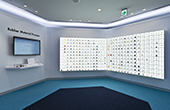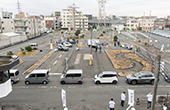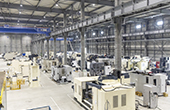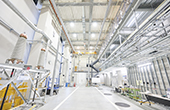Cars are in the midst of an extraordinary transformation. The trend toward electrification is accelerating and the market for connected cars permanently linked to the Internet is booming. Moreover, the era of autonomous cars, which has a long history in the realm of fantasy, may well become an everyday reality before long.
So what marvels does the evolution of cars have in store for us? For one thing, the number of electronic devices in the typical car is soaring. And to orchestrate all these devices that control numerous functions, you have to supply electricity and signals throughout the vehicle. This is what a wiring harness does. It’s an assembly of many electrical cables and wires combined with numerous connectors, clamps and so forth that connect all the devices. What the blood vessels and nervous system are to your body, so the wiring harness is to your car. I visited Yokkaichi Plant and Tsu Plant of Sumitomo Wiring Systems, which is a top-tier supplier of wiring harnesses to the global automotive industry.
The more electronic devices there are in a car, the greater the number of circuits needed to connect them. For example, seat heaters, previously an option limited to premium vehicles, are now commonplace in compact cars. The inexorable upward trend in performance and functionality is spurring the proliferation and growing complexity of wiring harnesses. Where will it all end?
No worries. Sumitomo Wiring Systems is developing new technologies and products in step with the progress of cars. For example, aluminum harnesses are a world first from Sumitomo Wiring Systems. “We are the first in the world to employ highstrength aluminum alloy wire in engine harnesses, instead of the copper wire conventionally used. As a result, the weight is halved without reducing the number of circuits,” says a smiling Ms. Hyunju Kim of Corporate Communications at Sumitomo Wiring Systems with evident pride. In another breakthrough, for electric vehicles the company has developed under-floor pipe harnesses that enclose high-voltage harnesses, making it possible to handle large currents while shielding against electromagnetic noise. A wide choice of wiring harnesses is available to meet the needs of different vehicle types and environments.
At Yokkaichi Plant, my first destination, I viewed the manufacturing of instrument panel harnesses, which are among the most structurally complex wiring harnesses. The instrument panel of a car accommodates various meters and numerous features, including controls for air conditioning and entertainment systems as well as airbags. There may be as many as 600 circuits.
Although processes for cutting various kinds of wires to the required lengths according to the vehicle type and attaching metal connection terminals are automated, almost all subsequent processes are done manually because of the huge number of devices involved. A single error in wiring is all it takes to cause a defect. The people performing these processes are true professionals. Yokkaichi Plant has received no customer complaints for 2,000 days and is maintaining its defect-free performance.
The overseas plants that are responsible for 90% of Sumitomo Wiring Systems’ manufacturing inherit this meticulous devotion to quality.
“Our principle is ‘Globally Uniform Best Quality.’ To achieve this, we need to provide education and training of consistently high quality for all our people at all our sites worldwide. Yokkaichi and Tsu are hub plants that prepare for the introduction of new technology overseas and provide technical support to overseas sites.” (Ms. Kim)
Over 200,000 people work each day at Sumitomo Wiring Systems’ sites in 32 counties around the world. At the annual Wiring Harness Skill Contest, they relish the opportunity to display their skills. Contestants selected from the company’s plants around the world compete for the accolade of best in the world. I tried “half wrapping,” one of the events in the contest, which involves wrapping a bundle of 50-centimeter-long wires with a 19-milimeter-wide black adhesive tape, always making sure that just half the tape overlaps. The record for this event is about 12 seconds. However, speed is only one criterion as greater importance is accorded to quality, such as the optimum number of wraps, all wrinkle-free of course. After one minute, I was still struggling with no end in sight.
In the annual Wiring Harness Skill Contest held in Japan, contestants selected from among outstanding operators around the world compete to find out who is the best of the best. Teams from factories in Vietnam and China are among the most frequent winners (leftabove). I had a go at “half wrapping,” but didn’t make the cut (rightbottom).
While continuing to refine manual skills, with its heart set on becoming a “mega-supplier” whose core products are wiring harnesses, Sumitomo Wiring Systems is vigorously promoting automation of production lines to enhance productivity. At the forefront of this drive is Tsu Plant, which manufactures various connectors, engine control units (ECUs), and components for hybrid vehicles. Among the numerous machines, robotic arms were diligently performing complicated tasks with deft movements that seemed anything but mechanical in appearance. I was moved by their conscientiousness. While touring the two plants, I realized that meticulous monozukuri involving seamless collaboration between people and machines is powering the advance of automobiles toward what promises to be a remarkable future.

 EN
EN





















































